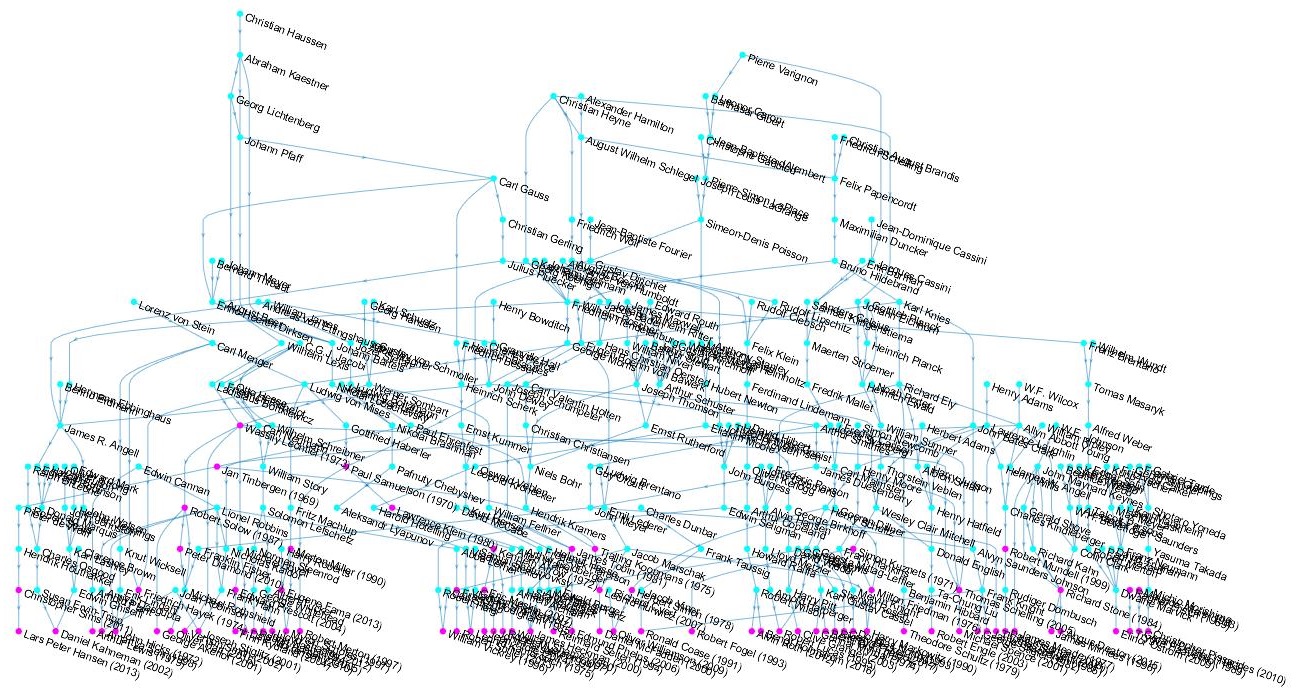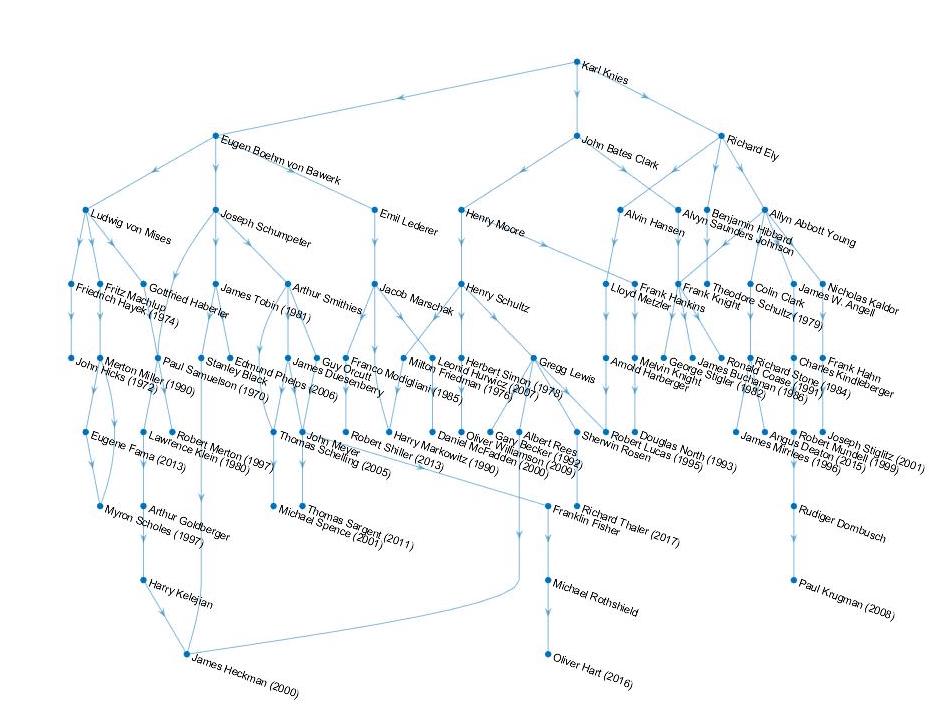The Nobel networkFigure 1 shows the complete network for 2017; a video of all networks since 1969 is available here. It has a number of remarkable features.
The Nobel network has a gender-ratio that is even more biased towards men than the economics discipline as a whole. There are 350 men in the graph, and four women. There are 78 male and one female Nobelists.
There are four disjoint graphs: Frisch-Haavelmo; Allais-Debreu; Pissarides; and all other Nobelists. The final network is messy, as professors group and regroup to advise different students, and professors team up with their students and grandstudents to teach a new generation – but the key point is that Nobelists are connected.
You can interpret the close relationships between Nobelists as a manifestation of the clustering of quality – the best professors congregate in the best schools (Ellison 2013), reinforce each other (Bosquet and Combes 2017), and select the best students (Atheyet al. 2007). You can also see this as a manifestation of the feudal nature of academia and the nepotism that implies (Combes et al. 2008).
New Nobelists are often closely related to previous Nobelists, but not always. The largest changes in the network were in 1975 (Kantorovich and Koopmans), 1971 (Kuznets), 1994 (Harsanyi, Nash, and Selten), 2002 (Kahneman and Smith), and 2009 (Ostrom and Williamson). Kahneman and Ostrom are not as alien to the economics profession as sometimes claimed.
Karl Knies is the most influential professor. A relatively obscure member of the German Historical School, Knies is not nearly as famous as his students Herbert Baxter Adams, Eugen Böhm von Bawerk, John Bates Clark, Richard T Ely, Richmond Mayo-Smith and Edwin Seligman. Wassily Leontief is the second-most influential professor. Figure 2 shows the subgraphs for Knies (37 Nobelists, all distant) and Leontief (15 Nobelists, most close).
The great classical economists (Smith, Say, Ricardo, Malthus, Mill) or preclassical economists (Ibn Khaldun, Petty, Quesnay, Cantillon, Turgot, Galiani) are unconnected to the Nobelists. Only one of the neo-classical revolutionaries is – Carl Menger. Marshall, Walras, Jevons, Pareto, and Pigou made enduring contributions to economic thought, but only through their writings, not through their students. In those days, apparently, economics was not yet a discipline that could be taught to young scholars, or at least the leaders of the profession did not see it this way.
This is specific to economics. Scholars in the humanities and natural sciences can trace their ancestry to great names of times past, and indeed many economists descend from famous non-economists – including people whose work we use, such as the Bernoullis, Gauss, Lagrange, Lyapunov, and Pearson, and people whose work is less obviously relevant, such as Bohr, Erasmus, Heisenberg, Luther, and Maxwell. In other words, economics was taken over by people from other disciplines, much like economists now work on subjects that traditionally were the exclusive domain of political scientists, anthropologists, psychologists, and biologists.
Figure 1 The complete professor-student network of Nobel Prize Laureates in Economics

Note: Nobelists are marked in magenta.
Figure 2 Selected subgraphs: Knies and Leontief


The key places of learning, ranked by their total centrality in 2017, are Harvard and Chicago, in that order, followed by Berlin, Göttingen, Vienna, Heidelberg, Cambridge, LSE, MIT, and Columbia. There have been dramatic shifts in the geography of economics teaching – in part because of people fleeing the Nazis (Haberler, Hayek, Hurwicz, Machlup, Marschak, von Mises, Morgenstern) and Bolsheviks (Leontief) (see also Waldinger 2012). But this is only a partial explanation. Ely (1938: 43) writes that ”[y]ou learn here [in Germany], and only here, how to do independent, real scientific work.”
Nobel candidatesLikely candidates for future Nobel Prizes were taken from Clarivate’s 2017 list of Citation Laureates.
The current network is likely to produce future winners – 24 of the 47 candidates have a Nobel ancestor, and others share ancestors with Nobelists. George Loewenstein, Sam Peltzman, and Marc Melitz are closest to the current network; Peltzman is closest to the Nobelists in the network. Franco Modigliani, Milton Friedman, John Hicks, and Tjalling Koopmans are closest to the candidates; Paul Samuelson, Lawrence Klein, Robert Mundell, and Peter Diamond are furthest removed.
New networks may emerge as well, particularly around the students, grandstudents and great-grandstudents of Terence Gorman and Denis Sargan.1 Anne Krueger is the only woman among the Nobel candidates.
ConclusionQuantitative history should be complemented by rich narratives. Additional data should be collected too, for example, on ethnicity and specialisation. To get a better sense of just how special our Nobelists are, a better coverage of earlier PhD programmes is needed, including those graduates who were less successful academically.
ReferencesAthey, S, L F Katz, A B Krueger, S Levitt and J Poterba. 2007. “What does performance in graduate school predict? Graduate economics education and student outcomes”, American Economic Review 97(2): 512–520.
Bosquet, C and P-P Combes (2017), “Sorting and agglomeration economies in French economics departments”, Journal of Urban Economics 101: 27–44.
Combes, P-P, L Linnemer and M Visser (2008), “Publish or peer-rich? The role of skills and networks in hiring economics professors”, Labour Economics 15(3): 423–441.
David, S V and B Y Hayden (2012), “Neurotree: A collaborative, graphical database of the academic genealogy of neuroscience”, PLoS ONE7 (10): 1–12.
Ellison, G (2013), “How does the market use citation data? The Hirsch Index in economics”, American Economic Journal: Applied Economics 5(3): 63–90.
Ely, R T (1938), Ground Under Our Feet - An Autobiography, New York: MacMillan.
McCarty, M H (2000), The Nobel Laureates: How the Greatest Economic Minds of Our Time Shaped Modern Thought, New York: McGraw-Hill.
Tol, R R J (2018), “Rise of the Kniesians: The professor-student network of Nobel laureates in economics”, University of Sussex Department of Economics, Working Paper Series 0518.
Vane, H R and C Mulhearn (2005), The Nobel Memorial Laureates in Economics: An introduction to their careers and main published works.
Waldinger, F (2012), “Peer effects in science: Evidence from the dismissal of scientists in Nazi Germany”, Review of Economic Studies 79(2): 838–861.
Endnotes[1]The registrar of Harvard argues that student-professor relationships are private information. This makes it hard to connect David Alhadeff and Stephen Ross to their students.

 扫码加好友,拉您进群
扫码加好友,拉您进群